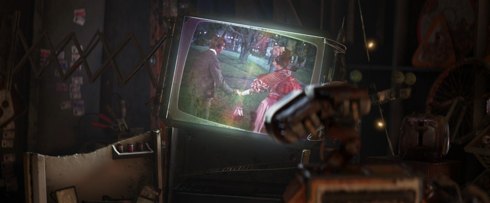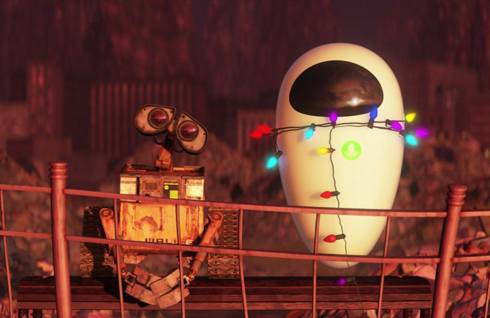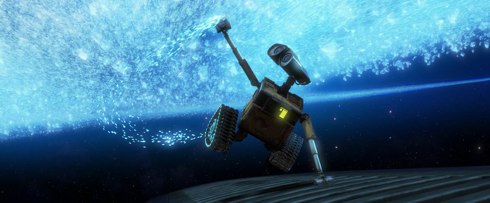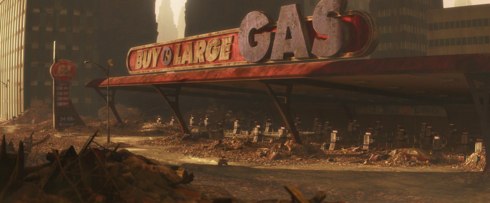Wall-E is generally referred to as a children’s film, and I’m not going to argue: it’s an excellent children’s film—a classic, absolutely. I also happen to think that it’s an even better movie for adults, for whom its lessons are more poignant, possibly more resonant, and more necessary. Pixar has a knack for producing films which consistently operate on two different levels: one which speaks to a young audience without condescension or pandering, and one which reflects adult experience, rather than just exploiting nostalgia for idealized conceptions of childhood or simply spiking the cinematic punch with snarky, Grown-Ups Only pop culture references and in-jokes.
Movies like Wall-E and Up deftly evoke complicated emotional responses in adults in a way that most children’s films don’t, speaking to adults on their own level through smart, subtle storytelling that’s often amazingly, heartbreakingly simple. Consider the opening sequence of Up, for example, which has the power to make grown men break down and sob as if they’ve just been kicked in the heart, but doesn’t seem particularly traumatic for small children at the same time; it’s not that kids don’t “get it”—they just don’t necessarily react to the sequence in the same way that adults, carrying a little more emotional baggage into the theater, tend to respond.
Wall-E is Pixar’s most sustained and arguably most successful experiment in employing this radical narrative simplicity. For the first twenty minutes of the movie, there’s basically no spoken dialogue, only recorded human voices echoing around a long-abandoned Earth. During the making of the movie, the Pixar team studied and drew inspiration from silent films, particularly those of Chaplin and Buster Keaton, and the influence is palpable throughout the movie, but especially in these opening scenes.
The irony, of course, is that the era of the silent film greats was defined by the limits of available technology—these artists were driven to perfect a unique mode of expression because of the challenges they faced in the early days of cinema. Wall-E himself is literally a product of technology, the discarded creation of a society with no such limits, but also no vision, which eventually self-destructed in a downward spiral of mindless consumption and apathy. In Wall-E’s reality, there isn’t any dialogue because there’s no longer anyone to talk to, to talk with. Oddly enough, when we eventually get a glimpse of human existence later in the movie, there’s still no dialogue—plenty of noise, prerecorded messages, automated announcements, and verbal commands, but no conversation, and certainly no meaningful interactions between people.
Wall-E shares a kinship with Keaton and Chaplin that goes beyond his movements and mannerisms—in short, he is an artist. The opening scenes of the movie establish the fact that he possesses a remarkable capacity for aesthetic appreciation. His function, as a robot, is to clean up the planetful of garbage left behind by humanity—a mindless, thankless task, or it would be, if he wasn’t able to spend his days sorting through the rubble, collecting objects which appeal to his natural curiosity and sense of beauty. His prized possession, of course, is a beat up VHS tape of Hello, Dolly!, his (and our) only link to a vibrant, thriving human past. In a sense, Wall-E is the last holdout of romanticism, stranded in an isolated industrial wasteland—and where Keats had a Grecian urn and Wordsworth had all sorts of abbeys and daffodils to inspire him, Wall-E’s experience of the sublime stems from a random 1969 Barbra Streisand musical…and that is genius.

I love that we’re never given any background on Hello, Dolly!, no belabored exposition on what it was and why we should care, no cute backstory about Wall-E finding his precious video cassette—all that matters is the feeling it evokes, within the context of the story. It’s such a fascinating choice for such a central plot device—a bloated, big-budget spectacle that was both one of the last great Hollywood musicals (directed by none other than the legendary Gene Kelley), and also a box office disappointment which helped usher in the end of an era, as cheery showtunes and sequins failed to impress late 60s audiences more interested in edgier fare. The movie version of Hello, Dolly! isn’t iconic enough to be instantly familiar to most audiences, but that fact makes it such a brilliant choice in a movie that urges you to look at the world differently, to appreciate the inherent value of creation and expression wherever you can find it.
Through Wall-E’s eyes, a campy sixties musical suddenly becomes a lightning rod of varying emotions: joy, longing, passion…it brings Wall-E and EVE together, reunites them when they’re separated, and even serves as a call to action in a robot revolt in the second half of the movie. When the captain of the Axiom starliner views the recorded video of Earth stored in EVE’s memory, he’s initially discouraged—until the clip of “Put on Your Sunday Clothes” magically appears, steeling his resolve and inspiring him, finally, to return to Earth. The lesson is driven home again and again: singing, dancing, music, and art have the power to connect, to further our understanding of the world; art is how we communicate; it can inspire revolution, redemption, and change for the better.

More than anything else, Wall-E is a movie about the importance of appreciating and creating art—without it, we are cut off from each other, and from ourselves. As far as depictions of dystopian futures are concerned, the movie is rather gentle—nothing about the cushy Axiom is likely to traumatize small children… but at the same time, its indictment of a culture entirely devoted to the mindless consumption of “entertainment” with no artistic merit or intellectual value is chilling the more you think about it. And the movie really, really wants you to think about it.
When you get right down to it, Wall-E can be considered Pixar’s mission statement; it’s basically a gorgeous, animated manifesto. Over and over again, it drives home the point that civilization and self-expression go hand in hand—humanity is defined by its ability to move beyond mere survival into the realm of art: it’s no coincidence that, after meeting Wall-E, the captain’s crash course in the history of the world moves from learning about basics like “soil,” “earth,” and “sea” directly into “hoedown” and “dancing”: this is a natural progression, according to the movie’s logic. Wall-E spends 700 years on his own (Hal, his adorable cockroach friend notwithstanding), but as soon as he encounters EVE, he immediately attempts to reach out to her by building a sculpture in her image–that gesture alone betrays more passion and humanity than any of the any of the actual humans in the movie are capable of mustering, until the very end. And this is why I think adults may have more to learn from Wall-E than kids do….
George Carlin famously said, “Scratch any cynic and you’ll find a disappointed idealist.” For me, more than anything else, Wall-E is a movie that speaks directly to the cynics, the apathetic, and to anyone who has lost touch with the fundamental urge toward creativity and expression, with the sheer joy and heights of emotion that art can bring. Just watching the closing credits is inspiring, as they move through the style of cave drawings, Greek and Roman art, Seurat, Van Gogh, all the way up through 8-bit video game-style graphics. It drives home the message that the world is full of inspiration, sometimes where we least expect to find it. It’s clear that the folks at Pixar see themselves as participating in this grand tradition that includes everything from ancient graffiti to Renaissance masterpieces to Modern Times, and 2001, and even Hello, Dolly! Every aspect of this movie is imbued with the power of its creators’ convictions: Wall-e is Pixar’s luminous love letter to the creative process…one which will hopefully continue to inspire adults and children alike for many years to come.

Bridget McGovern is making it her mission in life to mount an all-robot production of Mame, just as soon as she finishes building her Bea Arthur-bot.











Wall-E is one of my favorite Pixar films (which automatically makes it one of my favorite movies). I had a strong emotional reaction to several scenes it (that’s a fancy way of saying that it made me cry) and not just to the “sad” scenes – Wall-E dancing to the video and Wall-E and Eve flying around the ship did it, too. And don’t get me started on Up.
Two things (out of many) about Wall-E that made me realize the genius of Pixar:
They manage to get an amazing amount of emotional expression out of a robot that doesn’t have malleable features. Of course, the eye movements and body language do most of it, but there is a scene toward the end where he moves one part a small fraction of an inch and that one movement immediately conveys that he is “there” and not just a mindless machine. I remember the gasps and sighs from the audience during that scene.
The other thing is that I saw it on opening weekend and there were a lot of kids in the audience. I was regretting not going to a late showing or a weeknight because all of the kids were jumping around and talking. This continued through the trailers. During the Pixar short, there was lots of loud laughing and talking. But during the first 20 or so minutes of Wall-E, with no “action” and no dialog, the theater was very quiet. I’m sure some of the kids may have been bored, but I didn’t hear any “Mom, I want popcorn” or “I wanna go”.
It’s also a movie that makes you feel really bad if you ordered a large popcorn and Coke before sitting in your big soft reclining stadium seat to watch it. When we left, my wife said, “Great. That movie makes me want to walk home.”
I love Wall-E. It’s definitely my favorite Pixar film and your tribute here was wonderful as well. Thank you!
Well said, Bridget. Now I want to watch the movie again.
I adoreWall-E. That little trash compacter manages to say so much without saying anything at all. It’s great to see that movie get some well-deserved love.
I didn’t cry when I saw the “history of art” sequence in the theater, because I was too overwhelmed. It was like my tear ducts had been fried shut.
That sequence was more than the history of art; it was a future history of how humanity and the bots rebuild the ecosystem and create a new civilization. One with, apparently, gorgeous rennaissance cities. My thought on seeing that the first time was something like: “Do we really deserve that? After how we utterly ruined things the first time around?” And an overwhelming sense of relief. (“We deserve it by making it happen.”)
When I saw the sequence via DVD at home, I openly sobbed.
Wall-E is part Velveteen Robot, part Pixar slapstick, part . . . well, I can picture the SF satirists of the 50s and 60s coming up with Buy n’ Large and the inhabitants of the Axiom.
* * *
Perhaps the most surprising thing associated with Wall-E is the short-lived Buy n’ Large satire site. It was savage, featuring product write-ups and snippets of news from a world of corporate domination. It was apparently put together by Pixar folks. Eventually, it was pulled and the address redirected to a Disney promo page.
But not all of it was lost. The site disclaimer escaped the fate of the rest of the site:
http://www.buynlarge.com/disclaimer/disclaimer.html
I’m definitely in the “Favorite Pixar Movie” group with Wall*E (Up is definitely a VERY close second). The sound design alone is so fantastic, not to mention everything you listed.
I love this movie so, so much. One of my absolute favorites, and perfect in nearly every way. Wall-E and EVE have a total of about three lines between them, and yet they have characters as well-defined, relatable, and authentic as any I have ever seen on film. Pure genius.
I tear up every time “Down to the Ground” starts up and the credits roll.
Thank you for this wonderful articulation of what Pixar is all about. The briliance of a well crafted story is that even when you know it going to be all right you still cry at the sad parts.
One of the most important premises about ART underling Pixars work is that art is about comunication, and every thing they do is a poke in the eye to people who maintain that its only art if most people don’t “get it”. To quote Larry Niven, “writers who write for other writers should write letters.” (emphasis mine)
See, what i really like about those credits is it avoids so much science fiction luddism like Battlestar Galactica, saying that all this tech will be the end of us and we can start again by farming, foraging and making our own clothes! No, you see them rebuilding the world with the help of their technology.
A nice tribute though.
@politeruin: That made me think of the odd poem “Machines of Loving Grace.”
http://www.redhousebooks.com/galleries/freePoems/allWatchedOver.htm
Interesting! That’s a new one for me. There’s a current Adam Curtis documentary on the BBC with that very title but taking a somewhat different tack. So that’s where it comes from. Thanks.
https://secure.wikimedia.org/wikipedia/en/wiki/All_Watched_Over_by_Machines_of_Loving_Grace_%28television_documentary_series%29
What I love most about WALL-E is its depth of subtext. People will be talking and writing about this movie for a long time because there are so many ways to approach it, and people are still coming up with new ones, e.g. the treatment here of the movie as a statement on art and free expression. Thanks for a thought-provoking essay!
This is the best peice I have ever read on this site. Bravo.
I actually liked Up better than Wall-e, and have watched it more often with my kids, but that’s probably because where Wall-e focuses on the grander, larger context of human interaction, Up hits me where I live. I recognize myself in Russell, longing for more of a father than I ever had, and it was all to easy to recognize myself in Carl, so focused on the dream that I forget to look around at what I do have, which in many ways, in the important ways, is greater than the dream itself. As much as I resonated with Carl’s bittersweet relationship with his past, and with Ellie, the cathartic release when he finally turns the page in Ellie’s travel journal is the most poigniant and powerful moment I have ever experienced on film. And I’m 32, and it’s a cartoon. Simply unbelievable. Pixar is the most outstanding studio in existence today.
@8: I was afraid I was the only one. :)
Well said. Wall-E is definitely my favorite Pixar film (with Up as my second choice). It seems to be a film that has a little something for everyone.
Saw this movie opening weekend with my parents and my fiance. Oh, and it just happened to be the day before we were married. This movie not only instantly became one of my favorite movies of all time, but the emotional componant of seeing this film right before I got married can never be removed from my appreciation of it. To this day, my husband and I will hold hands like Wall-E and EVE with little clamps. I’m glad that it got the attention it deserves.
Thanks so much for the comments and kind words, everyone! I love that discussions of Up and Wall-E tend to go beyond the usual “It was good, the animation was great, I liked the celebrity voices, etc.” Instead, you get people looking to discuss the films as a shared experience–it’s like the best kind of bonding excercise, really :)
And don’t even get me started on the tear factor–I’m generally not much of a crier, but I’ll be forever grateful to the total stranger sitting next to me at Up who brought enough tissues to share. There’s such a difference between the cheap emotional manipulation you find in 90% of movies and the kind of genuine emotional catharsis Pixar films generally provide–it connects the whole audience in a way that still amazes me. I’m glad you all seem to think so, too…
Enjoyed Wall-E a lot too, but was annoyed at how the helpless humans are all shown as fat, and even more so at all the gendering of robots–extremely unnecessary and distracting. I loved “Up” except for the stereotyping about old people and prunes.
But what if they had made the EVE robot matte black instead of white?
Would that have seemed scary at first, and how culturally conditioned is that?
Angipotus @@@@@ 19:
Wow… um. First off, the “cultural conditioning” of white=good, black=scary has nothing to do with ethnicity, or race, if that’s what you are implying. It has to do with night and day. Dark and light. Things that go bump in the night. It existed in western culture long before our first encounters with the continent of Africa. Was it later applied to race relations? Sure it was. But the conditioning itself has nothing to do with any sort of people group.
Stereotypes, when applied to comedy (or any storytelling, for that matter), act as a universal shorthand that allows the creator to place more meaning into less space than s/he would otherwise be able to do. Stereotypes eliminate the need for a lot of backstory and and other world/character building. As applied to comedy, by utilizing a stereotype, you don’t have to “set up your joke”, because the set up is already universally known. Stereotypes insure your audience will “get it” with a minimum of explanation.
I suspected that the sinister-ness of black might be partly hardwired; I haven’t time to go into some of the interesting things about color. Stereotyping, though… I have my doubts about some of the “meaning” that is packed into an image, when it contributes to or reinforces harmful myths (fat people as lazy, old people as constipated, and don’t get me started on gender.) I’d think carefully about what I wanted my audience to “get”.
As far as Wall-e goes, the fat people weren’t lazy… the lazy people went fat. That’s hardly the same thing, and it’s patently obvious from the last hundred years that that particular trend, at least, is right on. The obesiety curve in America, at least, is right on with the technology curve. As we find ‘better’ and cheaper, and more efficient ways of doing things, we inevitably end up doing less physical work.
Is it realistic that NOBODY on that space ship ever went to a gym to stay in shape? Probably not. But hyperbole is another standard storytelling tool. Exagerate to make a point. The point wasn’t that fat people are lazy. It was that a culture that hands off ALL its responsiblities will inevitably grow soft and completely dependant. I didn’t really see them as fat people, I veiwed them as big, chubby babies that couldn’t do anything for themselves anymore.
@Fat Comments: Don’t forget that they’d been on the Axiom for, if I remember right, 700 years. In that time, they’d been in those chairs, with access to that food AND under artificial gravity that didn’t have the same effects as Earth’s gravity. The scene where the Captain stands for the first time in who knows how long and takes his first baby steps towards fighting the Autopilot were right on the money. Furthermore, when they get BACK to Earth, they all walk and stop using the chairs. It wasn’t mocking fat people and calling them lazy, it was mocking overpriliged people who turned into cartoonish (for lack of a better word) looking fat people because of their insistance on technology doing things for them. The Captain didn’t even know they had a work-out area. It perfectly fit with the overall message of Wall*E and as a fat person, I was not offended or bothered or even thought that I was having a finger pointed at me.
Lesser gravity would produce attenuated people; higher gravity would produce squat, strong people. As for recent history, some who have studied it more intently than I, claim that the link tween diet, action and weight is not so simple as many think. You and I know how hyperbole and stereotyping work and so on, but not everyone does, and the ones who don’t might wind up still believing that rotundity is a sign of laziness or helplessness. I still found both those shows enjoyable and moving.
I agree with every single thing this post says except the part about ithe film giving hope to cynics.
I would have agreed with that too, except that two different people said to me after seeing it that they had loved the movie right up until the dreadfully depressing ending where all the humans get off the ship and immediately (off-screen, but with obvious and utter inevitability) die.